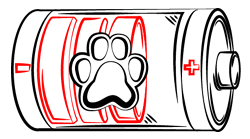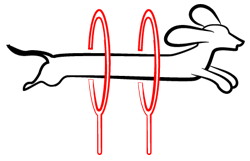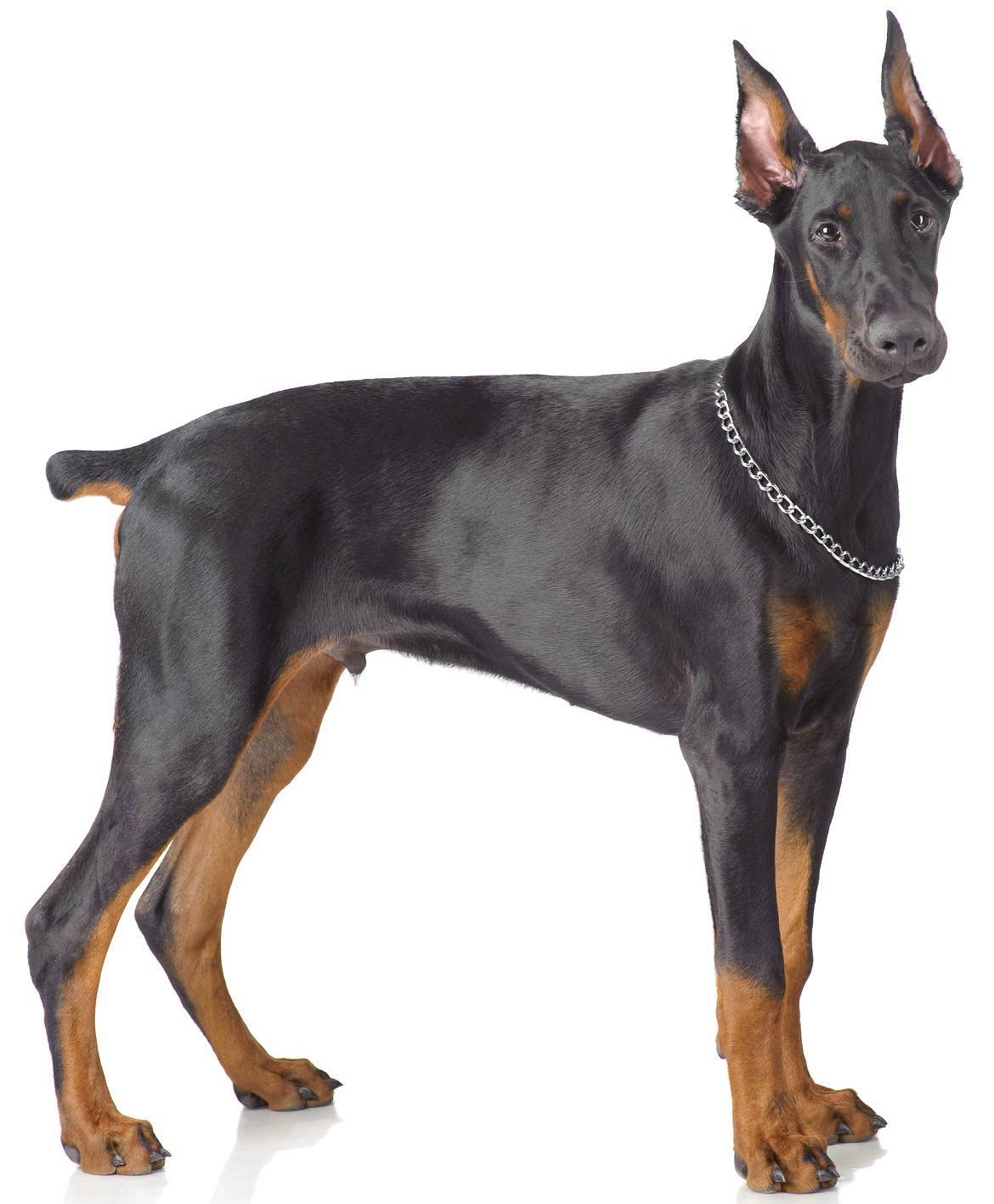
Paws ‘N’ Pups Quickview
Size
| Energy Level
| Trainability
| Paws ‘N’ Pups Rank
|
Characteristics
| Physical Characteristics: Height: 24-28” Weight: 60-100 lbs. Energy Level: Moderate-High | Colors: The American Kennel Club recognizes the Doberman in the following colors:
|
| Health & Longevity: 10-13 years Breeders screen for the following conditions:
Unfortunately, cancers are prevalent in the breed. Like many large, deep chested breeds, Dobermans are susceptible to gastric torsion (bloat), a life-threatening condition if immediate veterinary intervention is not sought. During periods of growth, some Dobermans experience Panosteitis, commonly referred to as “growing pains”. It is usually self-limited but the discomfort produced can range from mild to severe. Skin issues, Demodectic mange and allergies also exist in the breed. Wobblers Syndrome is common in Dobermans, as is IVDD and neuromuscular diseases. Color dilution alopecia is not uncommon in blues, and albinism exists, which puts these dogs at risk of sunburn, cancers and eye problems. | |
Temperament & Train-ability
The Doberman Pinscher is an alert, athletic working dog that is as sensitive as he is protective. A Dobe (as they are affectionately referred to) owner must be willing to accommodate their high energy level, need for exercise, stimulation and near-constant companionship. Typically reserved with strangers, they are playful and devoted to their people. A Dobe requires an experienced owner; novices will be completely unprepared for this breed’s level of maintenance. Naturally protective and territorial, they are reserved with strangers. Unethical or ignorant breeders sometimes produce sharp, aggressive dogs; this results in unpredictable and dangerous dogs that can be a nightmare (and huge liability) to live with. Do not cut corners when adding a Dobe to your family; take the time to find a responsible breeder producing stable temperaments.
Dobes are housedogs that must be part of the family; they are unsuited to spending long hours alone or living in a kennel with little human contact. Dobes are “Velcro dogs”; they want to always be touching you; some find this endlessly endearing while others are driven nuts by it. Emotional households are not a good fit, as the highly sensitive nature of this breed needs stability. This breed needs a job to do, every day. As family dogs, Dobes are recommended for older children. Just as your dog will need careful socialization to learn appropriate behavior around children, your children must be taught how to properly interact with your Doberman. Never allow children to sit on, attempt to ride or pull ears, etc. Children should be taught how to recognize when a dog needs a break and give them space. A Dobe is not a good choice for anyone wishing to frequent dog parks.
A minimum of two hours of hard exercise, mental stimulation and training are needed in order to avoid behavior problems such as nervousness, neurotic or destructive behavior. Their energy is matched by their intelligence, which is a demanding combination; they will find ways of their own to satisfy their needs if you don’t. Inappropriate chewing, food stealing, counter surfing, barking and other generally undesirable behavior awaits the poor soul who does not see to their Dobe’s needs. A secure yard is needed, for his safety as much as the people and animals that might wander onto his turf. Do not rely on underground electronic fences to contain a Doberman. They can be great jogging and cycling companions, but wait until growth is over (around 24 months) to avoid causing joint damage.
Dobes are susceptible to some breed specific legislation and discrimination. Many insurance companies require extra liability insurance for homeowners who have Dobermans. Dobes can be very dog aggressive, especially to dogs of the same sex. They are also often predatory with small animals and small dogs. A Dobe should never be allowed off leash as their hunting instincts can surface and they will be gone.
Sensitive and intelligent, the Doberman is not only trainable, but training is mandatory for this breed. Using positive reinforcement methods will certainly get you to your goals more quickly than force, but Dobes need consistent, clear leadership. If the rules are different from day to day, your Dobe will become stressed and anxious.
Dobermans require early and ongoing socialization to balance their naturally protective nature and avoid shyness or sharpness. Without this, your Dobe may see threats where none exist, which is a potential liability. Many Dobes excel in competitions such as obedience, agility, tracking and sports such as Schutzhund (IPO). Positive reinforcement methods will allow you to get the most out of your Doberman.
Grooming
The Doberman sports an easy-care, short smooth coat. They are moderate shedders, with most of their coat drop occurring in the spring and fall. Weekly brushing and occasional baths will keep hair in the house to a minimum. Typically clean with minimal odor, many owners favor wiping their Dobes down with a damp cloth over a traditional bath. Ears must be cleaned regularly, and toenails may need to be trimmed; even if your Dobe is walked on concrete, toenail trimming should be part of your regular grooming routine to keep your dog used to having their feet handled. Teeth should also be checked and cleaned as necessary.
Diet
The amount of food a Dobe will require can vary depending on age, activity level, and type of food fed. On average, Dobes will eat 2 1/2 – 3 1/2 cups of food, fed in two meals per day; free feeding should be avoided. A high quality food should be fed, but you may not need a high protein food. If allergies surface, a hypoallergenic food may be needed. At such times, some trial and error may be needed to find the right food for your dog.
Looking for a Doberman?
 Find A Doberman Breeder |  Doberman Puppies For Sale |  Adopt A Doberman |
Cost
Dobes run between $600-$2,000, with some going as high as $3,000-$5,000. Adopting a rescue dog is an option many prefer, in order to give a home to a dog in need. Whether you acquire a dog from a breeder or rescue, do your homework to be assured that the temperaments of the dogs are tested and sound.
Ongoing expenditures include the typical supplies, food, and regular vet visits. Additionally, you may need to invest in an extra supply of chew and food-dispensing toys as well as training classes to keep your busy Doberman occupied and healthy. Remember, too, everything costs more with a large dog; beds, the amount of food needed, as well as veterinary procedures. Don’t forget to consider whether your automobile can safely accommodate an adult Doberman.
Paws ‘N’ Pups Ranking
Paws ‘N’ Pups ranks every breed out of 4 with 1 being easiest to integrate into your life and 4 being the toughest – The lower the ranking the better.
Ranking takes into account a few basic factors such as cost, skill level needed, high vs. low maintenance, and how critical regular training is to success.
The Doberman rates a 3, due to their cost, the skill level needed to raise and keep them satisfied, and their need for ongoing training and mental stimulation.
Breeds Similar To Doberman
 Rottweiler | 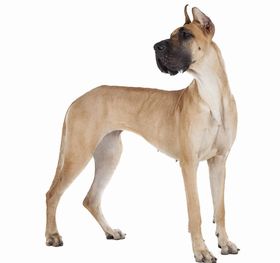 Great Dane | 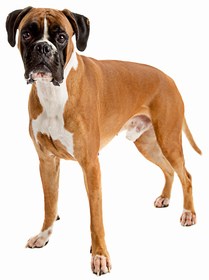 Boxer |  Bullmastiff |


